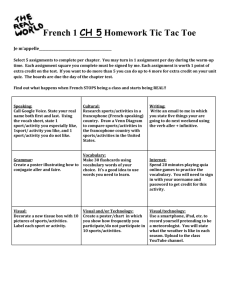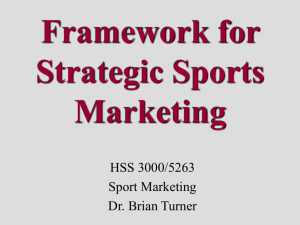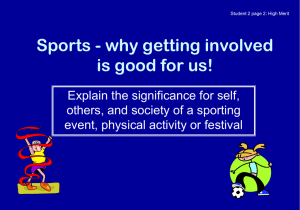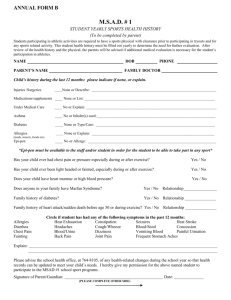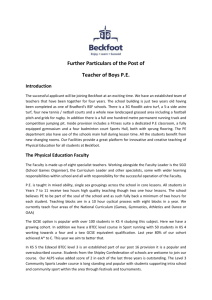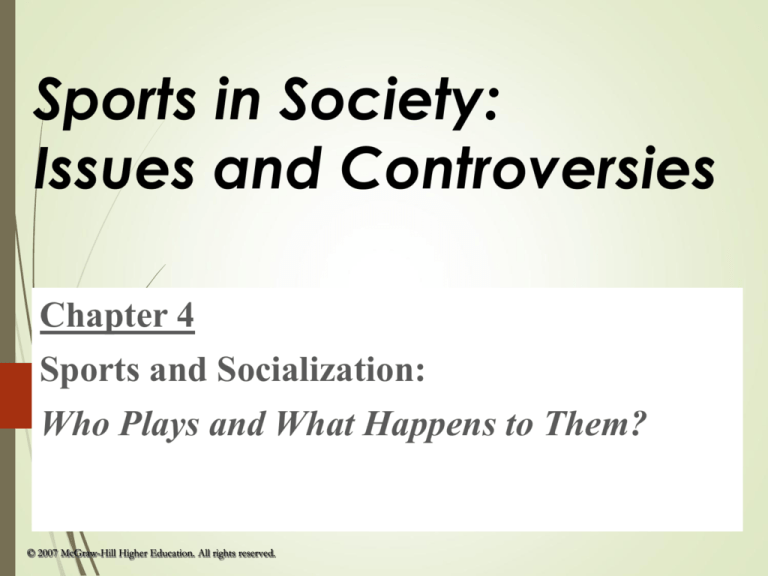
Sports in Society:
Issues and Controversies
Chapter 4
Sports and Socialization:
Who Plays and What Happens to Them?
© 2007 McGraw-Hill Higher Education. All rights reserved.
Are children influenced more
by athletes they see only in
the media, or by those who
play with them every day?
Research shows that people
choose role models they know
and with whom they interact
on a regular basis.
© 2007 McGraw-Hill Higher Education. All rights reserved.
Socialization: Main Definition
Socialization
Is an active process of learning and social development
Occurs as we
Interact with others
Become familiar with the social worlds in which we live
© 2007 McGraw-Hill Higher Education. All rights reserved.
Socialization:
A Functionalist Approach
1. The characteristics of those being socialized
2. The people who do the socializing
3. The context in which socialization occurs
4. The specific outcomes of socialization, i.e., the
types of learning that occurs
© 2007 McGraw-Hill Higher Education. All rights reserved.
Figure 4.1
Fathers are significant others
in socialization processes.
“I know this is starting early, but I can’t let him get too far behind
the other kids if he’s ever going to make a team in high school.”
© 2007 McGraw-Hill Higher Education. All rights reserved.
Socialization:
A Conflict Approach
How sports and sport participation divides people in
the working class
How people with few resources are denied
opportunities to play sports
The lack of rights among athletes
How money and power are used to control sports
and exploit others to maintain the status quo
© 2007 McGraw-Hill Higher Education. All rights reserved.
Socialization:
Interactionist Models
Utilize qualitative more often than quantitative
research methods
Obtain detailed descriptions of sport experiences and
cultures
Seek information on how people make decisions
about sports in their lives
Connect meanings given to sports and sport
experiences with the larger social and cultural context
© 2007 McGraw-Hill Higher Education. All rights reserved.
Becoming Involved and
Staying Involved in Sports
Functionalist research indicates that sport
participation is related to:
The influence of significant others
The availability of opportunities to play and to experience success in
sports
People’s abilities & characteristics
© 2007 McGraw-Hill Higher Education. All rights reserved.
Becoming Involved
& Staying Involved in Sports
Interactionist research indicates that
sport participation is related to:
Ongoing processes in people’s lives
Decision making processes in which decisions
Change as social circumstances change
Are not made once and for all time
© 2007 McGraw-Hill Higher Education. All rights reserved.
Significant others are important but continued participation
involves processes of social involvement and continuously
making a commitment to be an athlete
© 2007 McGraw-Hill Higher Education. All rights reserved.
THE WILLIAMS FAMILY
© 2007 McGraw-Hill Higher Education. All rights reserved.
The Peyton Family
© 2007 McGraw-Hill Higher Education. All rights reserved.
Stevenson’s Findings (1999)
Becoming an elite athlete involves:
The process of introduction and involvement
The process of developing commitment
© 2007 McGraw-Hill Higher Education. All rights reserved.
© 2007 McGraw-Hill Higher Education. All rights reserved.
Donnelly & Young’s Findings (1999)
Becoming an athlete in a sport
subculture involves:
Acquiring knowledge about the sport
Associating with people in the sport
Learning the norms of the sport
Receiving recognition and acceptance
from other athletes
© 2007 McGraw-Hill Higher Education. All rights reserved.
Coakley & White’s
Findings (1999)
Deciding to play
sports depends
on:
Ideas about sport’s
connection to other
interests and goals
Desires to develop &
display competence
Social and material
support
Memories of past
experiences in sports
General cultural images
and messages about
sports
© 2007 McGraw-Hill Higher Education. All rights reserved.
Functionalist and Conflict Theory:
Research on Changing or Ending Sport
Participation
People don’t drop out forever, nor do they cut all
ties with sports
Dropping out is tied to other changes and transitions
in a person’s life
Dropping out is not related only to bad experiences
Dropping out may cause problems among those
who
Have identities grounded totally in sports
Lack social & material resources
© 2007 McGraw-Hill Higher Education. All rights reserved.
MAGIC JOHNSON- Sport Businessman
© 2007 McGraw-Hill Higher Education. All rights reserved.
Coakley’s Findings
(1992)
Burnout among elite adolescent
athletes was most likely
when:
High performance
sports were organized
so that athletes had
little control over their
lives
Sport involvement
was perceived to
interfere with
accomplishing
important
developmental tasks
© 2007 McGraw-Hill Higher Education. All rights reserved.
Ending sport participation in high school or college does not
mean that participation is over forever. These seventy year olds
went to a national tournament
© 2007 McGraw-Hill Higher Education. All rights reserved.
Sometimes people end sport participation due to unfortunate
experiences; but most often they alter what and when they plays
sports in connection with other changes in their lives.
© 2007 McGraw-Hill Higher Education. All rights reserved.
Koukouris’ Findings (1994)
Ending or reducing sport participation was associated with:
The need to find a job and become independent
Realistic assessments of sport skills and potential for
future achievements
Efforts to stay physically active and connected with
sports
© 2007 McGraw-Hill Higher Education. All rights reserved.
Wheeler’s Findings
(1999)
When competitive sport careers
ended, the main challenges
faced by athletes with
disabilities were:
Reinvesting time and
energy into other
spheres of life
Reconnecting with
family members and
friends
Going back to school
and getting on with
occupational careers
© 2007 McGraw-Hill Higher Education. All rights reserved.
Summary: Changing or
Ending Competitive Sport
Changes
in participation are grounded in decisionParticipation
making processes tied to people’s lives, life
courses, and social worlds
Identity issues and developmental issues are
important
Problems are most likely when sport participation
has constricted a person’s life
© 2007 McGraw-Hill Higher Education. All rights reserved.
Being Involved in Sports:
What Happens?
In some cultures people believe that
playing sports automatically builds
positive traits (character) and
relationships among all participants
© 2007 McGraw-Hill Higher Education. All rights reserved.
© 2007 McGraw-Hill Higher Education. All rights reserved.
Factors Often Overlooked in Research on
Character Building in Sports
1.
Different sports offer different experiences
2.
Selection processes in organized sports favor
some characteristics over others
3.
Different people define sport experiences in
different ways
4.
Meanings given to sport experiences often
change over time
5.
Social relationships mediate sports
experiences
6.
Many activities other than sports can provide
character-building experiences
© 2007 McGraw-Hill Higher Education. All rights reserved.
Sport Participation Is Most Likely to
Produce Positive Effects When (I)
1.
New non-sport identities are formed
2.
Knowledge is gained about the world beyond sports
3.
4.
Experiences go beyond sports
5.
New relationships are formed that go beyond sports
(continued)
© 2007 McGraw-Hill Higher Education. All rights reserved.
Sport Participation Is Most Likely to
Produce Positive Effects When (II)
5.
Lessons learned in sports are applied to situations outside of sports
6.
Participants are seen by others as total human beings, not just
athletes
7.
General competence and responsibility are learned
8.
Meet mentors and advocates
© 2007 McGraw-Hill Higher Education. All rights reserved.
General Summary:
If playing sports constricts or limits a person’s life, expect negative
socialization effects
If playing sports expands or diversifies a person’s life, expect positive
socialization effects
© 2007 McGraw-Hill Higher Education. All rights reserved.
PART II
SPORT EXPERIENCES
Socialization
Is an active process of
learning and social
development
Occurs as we:
Interact with others
Become familiar with the
social worlds in which we
live
© 2007 McGraw-Hill Higher Education. All rights reserved.
All sports are not the
same when it comes
to socialization
experiences
© 2007 McGraw-Hill Higher Education. All rights reserved.
Some sports
emphasize
power and
performance,
others
emphasize
pleasure and
participation
© 2007 McGraw-Hill Higher Education. All rights reserved.
Power & Performance
Versus
Pleasure & Participation
Pleasure & Participation Sports
Power & Performance Sports
1.
2.
Use power to push limits in
pursuit of victories
Excellence proved through
winning
3.
Body = tool and weapon
4.
Competence-based
inclusion/exclusion
5.
Hierarchical structures
6.
Opponents = enemies
© 2007 McGraw-Hill Higher Education. All rights reserved.
1.
Emphasis on connections
between people
2.
Ethic of expression,
enjoyment, health
3.
Body = source of pleasure
4.
Inclusion & accommo- dation
of differences
5.
Democratic structures
6.
Compete with others
Sports and Health
© 2007 McGraw-Hill Higher Education. All rights reserved.
Sport Participation and
Health
The healthiest physical activities are rhythmic, noncompetitive
exercises in which people control and regulate body
movements
Health benefits decline in competitive sports
Health costs of competitive sport are due to
Injuries (cuts, teeth, knees, broken bones, spines)
Violence (when body is used as a weapon)
Risk taking (when athletes exceed limits)
Unhealthy lifestyles (disordered eating, drinking)
© 2007 McGraw-Hill Higher Education. All rights reserved.
Sport Participation and
Obesity
Physical activity reduces weight
When people equate activity with competitive sports,
activity rates often decline
Sports in which large bodies are valued encourage
overeating and other unhealthy weight gain strategies
– such as in the NFL where obesity rates are high
© 2007 McGraw-Hill Higher Education. All rights reserved.
Ms. Obama and Youth
Fitness
© 2007 McGraw-Hill Higher Education. All rights reserved.
Ms. Obama’s
Workout
If she's on the road, Mrs.
Obama often brings a jump
rope, she adds. "If I don't
have a rope or space, I
might do a 30-minute
routine that includes a
minute of jumping jacks
alternating with a minute of
push-ups, then some sit-ups.
You take a 30-second break
and do it again."
© 2007 McGraw-Hill Higher Education. All rights reserved.
Studies of Sport Experiences
The voices of sport participants indicate that
People define and give meaning to their sport
experiences in connection with their social
relationships
Meanings given to sport experiences are grounded
in cultural definitions about gender, race &
ethnicity, social class, sexuality, and other
characteristics defined as socially important
© 2007 McGraw-Hill Higher Education. All rights reserved.
Fine’s Findings
(1987)
The moral socialization that
occurs in little league
baseball
Depends on how the
boys “hear” and
apply the moral
messages from adults
Emphasizes
masculinity as
involving toughness
and dominance
© 2007 McGraw-Hill Higher Education. All rights reserved.
Sport has been one of the most important socio-cultural learning
experiences for boys and men for many years. Those same
benefits should be afforded our daughters. It is important for all of
us to know that:
High school girls who play sports are less likely to be
involved in an unintended pregnancy; more likely to
get better grades in school and more likely to
graduate than girls who do not play sports.
Girls and women who play sports have higher levels of
confidence and self-esteem and lower levels of
depression.
Girls and women who play sports have a more positive
body image and experience higher states of
psychological well-being than girls and women who
do not play sports.
© 2007 McGraw-Hill Higher Education. All rights reserved.
A LITTLE GIRL’S SPORT
EXPERIENCES
© 2007 McGraw-Hill Higher Education. All rights reserved.
Woog’s Findings (1998)
The personal stories of gay male athletes in the U.S. indicate that
Combining a gay identity with an athletic identity is often a challenging
process
Individual sports and “cosmopolitan” sports are more gay-friendly than
team sports and “macho” sports
Being out in sport is liberating, but it can also be dangerous
Being out is easier when friends, teammates, and organizations provide
active support
© 2007 McGraw-Hill Higher Education. All rights reserved.
Studies of the Social Worlds of Sports
Social world refers to a way of life and an
associated mindset that revolves around a
particular sport
Sport experiences and the actions of people in
sports can be understood only when placed in the
context of the social world in which they occur
© 2007 McGraw-Hill Higher Education. All rights reserved.
Adlers’ Findings (1991)
Athletes in high profile sports may experience a form of
“role engulfment” that
Deeply affects their identities and how they make decisions
about their lives
Separates them from the relationships and experiences they
need to have if they are to learn lessons from their sport
experiences
Influences how other people define and respond to them
© 2007 McGraw-Hill Higher Education. All rights reserved.
Klein’s Findings (1993)
The lives of bodybuilders revolve around issues of
gender and sexuality
Men and women learn to project images of power while
experiencing doubts about their identities and self-worth
The social world of bodybuilding fosters a desperate need for
attention and approval
Ideas about masculinity are so narrow that male bodybuilders
develop homophobic attitudes and self-presentations based on
caricatured ideas about manliness
© 2007 McGraw-Hill Higher Education. All rights reserved.
Crosset’s Findings (1995)
The lives of women athletes in the LPGA were influenced
by gender relations in U.S. culture
The women developed an “ethic of prowess” – a mindset
highlighting a commitment to physical competence as a basis
for evaluating self and others on the tour
This ethic existed to neutralize the negative effects of traditional
ideas about femininity
Conformity to the ethic helped the women legitimize their roles
as professional athletes
© 2007 McGraw-Hill Higher Education. All rights reserved.
Wacquant’s
Findings
(1992)
The social world of the boxing
gym
Was created in connection
with the social forces in the
black ghetto and its
masculine street culture
Sheltered black men from
the full destructive impact
of social and cultural forces
in their lives
Provided a disciplined
regime of body regulation
that established a positive
identity and separated the
men from the negative
influences of a chaotic
environment
© 2007 McGraw-Hill Higher Education. All rights reserved.
Socialization and Ideology
Sports are sites for struggling over how we think and
what we do
Sports are sites where people create and learn
“stories” they can use to make sense of the world
Sports consist of vocabularies and images that
influence ideology
© 2007 McGraw-Hill Higher Education. All rights reserved.
Socialization as a
Community and Cultural Process
Hegemony is the process of maintaining leadership and control
by gaining the consent of other groups, including those that
are being led or controlled.
Sports are important sites for hegemonic processes because they
provide pleasurable experiences for masses of people
Corporate sponsors use sports to establish “ideological outposts”
in people’s heads; this defuses resistance to corporate power
& policies
© 2007 McGraw-Hill Higher Education. All rights reserved.
Nike and other corporations
worked hard to sever the
“Jordan persona” from
African American
experiences. The French
liked this image on a Paris
building because they could
identify with Jordan without
acknowledging the legacies
of African colonialism and
racism that were part of their
culture. Jordan could be
seen with color blind eyes,
and this made whites
comfortable.
© 2007 McGraw-Hill Higher Education. All rights reserved.
Sport, Socialization, & Ideology
Research shows that none of us lives outside the influence of ideology
The stories that emerge in connection with sports
and sport experiences generally reproduce
dominant forms of ideology, but they also can
challenge and even transform dominant ideology
© 2007 McGraw-Hill Higher Education. All rights reserved.
The bodies of athletes with
disabilities challenge
expectations in the Empire of
the Normal. Athletes with
disabilities are expected to
have stories that explain “why
my body is different from your
body.” This influences their
socialization experiences and
their identities as athletes.
© 2007 McGraw-Hill Higher Education. All rights reserved.
What Socialization Research
Doesn’t Tell Us
How socialization processes operate in the lives of
people from various ethnic groups & social classes
The dynamics of sport participation careers among
young children
How people make participation decisions about
different types of sports
© 2007 McGraw-Hill Higher Education. All rights reserved.
Figure 4.2
The meanings
given to sports
vary by person
and situation.
“I don’t think these guys agree about the
meaning of boxing”
© 2007 McGraw-Hill Higher Education. All rights reserved.
The Most Informative Research on
What Happens in Sports Deals with
1.
The everyday experiences of people who play sports
2.
The social worlds created around sports
3.
Community and cultural processes that are related to the
ideological messages associated with sports in society
© 2007 McGraw-Hill Higher Education. All rights reserved.
Summary
To Be Given Later
© 2007 McGraw-Hill Higher Education. All rights reserved.

